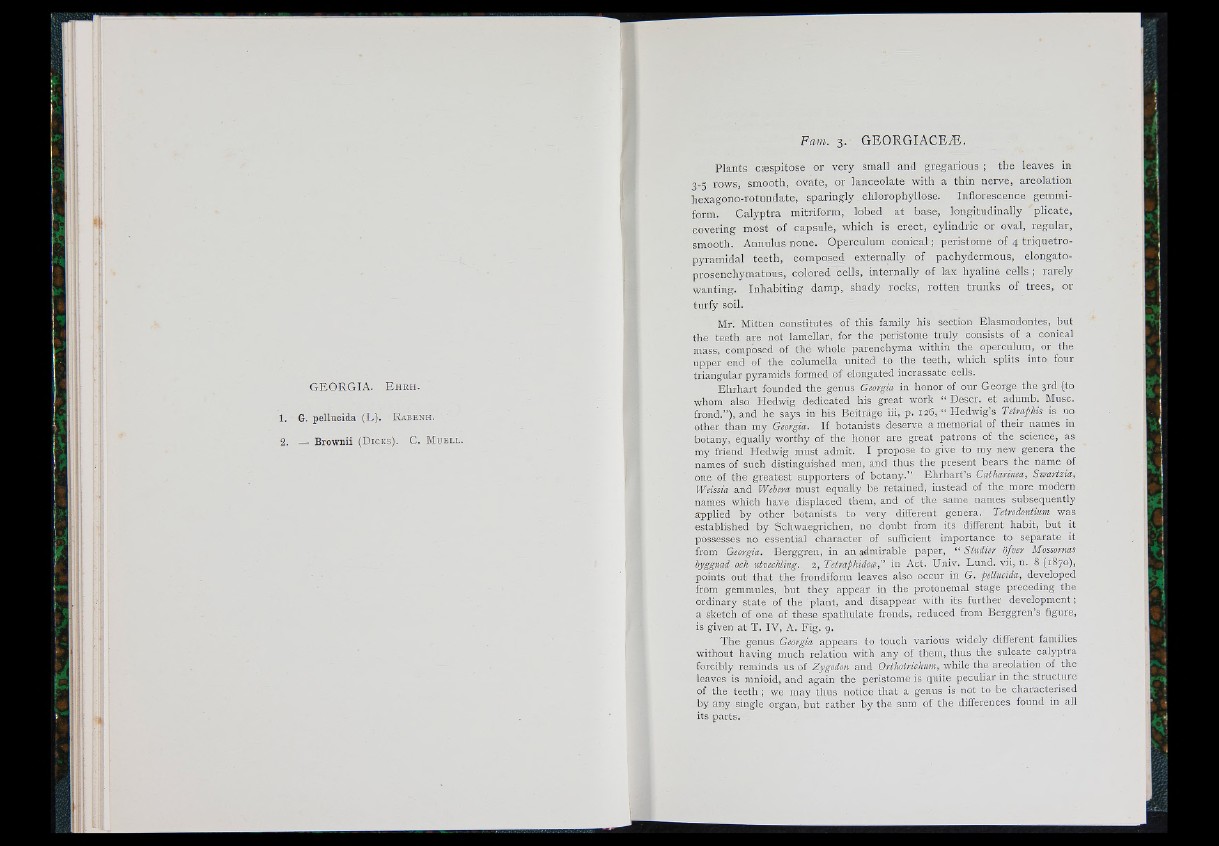
G E O R G IA . E h r h .
1. G. pelliicida (L). Rabenh.
2. — Brownii (Dicks). C. Muell.
Fam. 3. GEORGIACEzE.
Plan ts ciEspitose or very small and gregarious ; the leaves in
3-5 rows, smooth, ovate, or lanceolate with a thin nerve, areolation
hexagono-rotundate, sparingly chlorophyllose. Inflorescence gemmiform.
C a lyp tra mitriform, lobed at base, longitudinally plicate,
covering most o f capsule, which is erect, cylindric or oval, regular,
smooth. Annulus none. Operculum c o n ic a l; peristome o f 4 triquetro-
pyramidal teeth, composed externally o f pachydermous, elongato-
prosenchymatous, colored cells, internally of lax hyaline c e lls ; rarely
wanting. Inhabiting damp, shady rocks, rotten trunks o f trees, or
turfy soil.
Mr. Mitten constitutes of this family his section Elasmodontes, but
the teeth are not lamellar, for the peristome truly consists of a conical
mass, composed of the whole parenchyma within the operculum, or the
upper end of the columella united to the teeth, which splits into four
triangular pyramids formed of elongated incrassate cells.
Ehrhart founded the genus Georgia in honor of our George the 3rd (to
whom also Eledwig dedicated his great work “ Descr. et adumb. Musc.
frond.” ), and he says in his Beiträge iii, p. 126, “ Hedwig’s Tetraphis is no
other than my Georgia. If botanists deserve a memorial of their names in
botany, equally worthy of the honor are great patrons of the science, as
my friend Hedwig must admit. I propose to give to my new genera the
names of such distinguished men, and thus the present bears the name of
one of the greatest supporters of botany.” Ehrhart’s Catharinea, Swartzia,
Weissia and Weiera must equally be retained, instead of the more modern
names which have displaced them, and of the same names subsequently
applied by other botanists to very different genera. Tetrodontium was
established by Schwaegrichen, no doubt from its different habit, but it
possesses no essential character of sufficient importance to separate it
from Georgia. Berggren, in an admirable paper, “ Studier öfvev Mossornas
hyggnad och utveckling. 2, Tetraphidece," in Act. Univ. Lund, vii, n. 8 (1870),
points out that the frondiform leaves also occur in C. pethwida, developed
from gemmules, but they appear in the protonemal stage preceding the
ordinary state of the plant, and disappear with its further development;
a sketch of one of these spathulate fronds, reduced from Berggren’s figure,
is given at T. IV, A. Fig. g.
The genus Georgia appears to touch various widely different families
without having much relation with any of them, thus the sulcate calyptra
forcibly reminds us of Zygodon and Orthoirickum, while the areolation of the
leaves is mnioid, and again the peristome is quite peculiar in the structure
of the teeth ; we may thus notice that a genus is not to be characterised
by any single organ, but rather by the sum of the differences found in all
its parts.